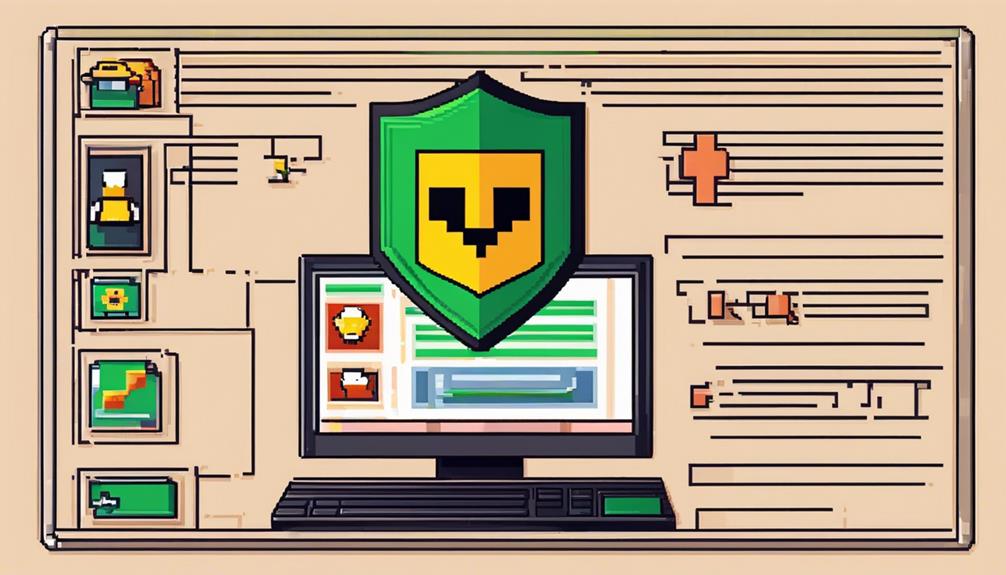To keep your browser extension safe from hackers, stick to official marketplaces for downloads. Avoid unverified sources. Check permissions upon installation and update them regularly. Keep extensions up to date for security. Remove any outdated extensions. Limit the number installed to decrease risks. Utilize antivirus software for added protection. Stay vigilant by reviewing permissions and researching extension reputations. These steps are essential for safeguarding your browser extension.
Key Takeaways
- Install extensions from official marketplaces for security.
- Regularly update extensions for patches and bug fixes.
- Review permissions to ensure alignment with functionality.
- Use antivirus software for real-time threat detection.
- Limit the number of installed extensions to reduce vulnerabilities.
Source of Extensions
Official browser marketplaces, such as Chrome Web Store, Firefox Add-ons, and Microsoft Edge Add-ons, are the most essential sources for browser extensions. They ensure heightened security and minimize risks of potential threats by offering a wide range of extensions that have been vetted for security and compliance with guidelines.
It is vital to avoid downloading extensions from third-party websites or unverified sources, as they may contain malicious software that can harm your device. Well-known developers and reputable companies often provide secure extensions with regular updates and support, giving users peace of mind when installing them.
Review Permissions

Reviewing permissions when installing a browser extension is essential for safeguarding personal data. By checking the permissions requested, users can limit unnecessary access and understand the extension's capabilities.
Regularly auditing permissions enhances security by identifying potential risks and ensuring only essential access is granted.
Check Extension Permissions
Securing browser extension safety begins with a thorough examination of the permissions granted to the extension. When evaluating extension permissions, consider the following:
- Assess the extension permissions to understand the extent of data and functions it can access.
- Confirm if the requested permissions align with the extension's intended functionality to avoid potential risks.
- Be wary of malicious extensions that demand unnecessary or excessive permissions, as they may compromise your data security.
- Regularly review and update permissions to ensure they remain relevant and appropriate for your needs. By granting permissions cautiously, you can minimize the risk of exposing your data to hackers.
Limit Unnecessary Access
To enhance browser extension security, meticulously scrutinize and restrict unnecessary access by thoroughly reviewing the permissions requested by each extension.
By limiting unnecessary access, you reduce the extension's attack surface, decreasing the chances of potential security breaches. Check if the permissions requested align with the extension's functionality to prevent overreaching access to your data.
Deny permissions that seem unrelated to the extension's purpose, as this can help minimize security risks. It's important to grant permissions only to extensions from trustworthy developers to further minimize the chances of data breaches.
Regularly reviewing and adjusting permissions for installed extensions is vital to maintaining a secure browsing environment. This proactive approach ensures that your data remains protected and that your online activities are shielded from potential threats.
Regular Permission Audits
Regularly examining the permissions granted to installed browser extensions is vital for maintaining a secure browsing experience. By reviewing the permissions requested by each extension, you can ascertain the level of access they have to your data and make sure it is necessary and appropriate.
To help you understand the importance of regular permission audits, consider the following:
- Check permissions regularly to prevent extensions from having excessive access to sensitive information.
- Auditing permissions can reduce the risk of data breaches and privacy violations through extensions.
- Unnecessary permissions increase the vulnerability of your data to potential security threats.
- Monitoring and adjusting permissions can empower you to retain control over the data accessed by your extensions.
Update Regularly

Regularly updating your browser extensions is crucial for maintaining security and protecting against potential cyber threats. By installing the latest updates, you guarantee that security patches are in place to address vulnerabilities that hackers may exploit.
Routinely checking for updates and enabling automatic updates can help keep your extensions secure and running smoothly.
Timely Software Updates
Keeping your browser extension up to date with timely software updates is essential for maintaining its security against potential vulnerabilities. When it comes to browser extensions like those on Google Chrome, staying current is vital to protect against exploits that hackers may target.
Here are some key points to keep in mind:
- Regular Updates: Make sure you regularly update your browser extensions to patch any security vulnerabilities that may exist.
- Security Patches: Updates often include security patches that fix known issues and protect against new threats.
- Hackers' Targets: Hackers actively target outdated extensions, making timely updates important for maintaining security.
- Automatic Updates: Set extensions to update automatically to ensure you have the latest protection without manual intervention.
Security Patch Installation
Consistent installation of security patches for browser extensions is imperative in safeguarding against potential security threats. Security patches are updates released by developers to address known vulnerabilities in the software. Regularly updating these patches helps protect against exploits that hackers may use to compromise user data.
Hackers often target outdated extensions with known security flaws, making timely updates essential for maintaining a secure browsing experience. Failure to update browser extensions leaves them vulnerable to exploitation, putting user privacy and security at risk. By keeping extensions updated with the latest security patches, users can reduce the chances of falling victim to cyber attacks.
These patches not only fix vulnerabilities but also enhance the overall security posture of browser extensions. Therefore, staying vigilant about installing security patches is a fundamental step in mitigating the risks associated with using browser extensions and ensuring a safer online experience.
Routine Maintenance Checks
To guarantee the ongoing security of your browser extension, it is essential to frequently update it with the latest patches. Regular updates help in patching security vulnerabilities and safeguarding against potential hacker exploits.
Here are some key practices to keep in mind for routine maintenance checks:
- Essential Updates: Make sure you regularly check for updates and apply them promptly to stay protected.
- Vulnerability Prevention: Updating extensions can help prevent unauthorized access to sensitive data, reducing the risk of security breaches.
- Automatic Updates: Setting up automatic updates for browser extensions can streamline the maintenance process and enhance security measures.
- Hackers' Target: Hackers often focus on known vulnerabilities in older versions of extensions, making routine updates essential for maintaining security.
Remove Outdated Extensions

By removing outdated extensions from your browser, you can greatly reduce the risk of potential security vulnerabilities being exploited by hackers. Outdated extensions may have unresolved vulnerabilities that hackers target to gain unauthorized access to user data.
It is important to regularly update extensions to maintain a secure browsing environment. Hackers often exploit outdated extensions as an easy entry point to compromise user information.
To remove outdated extensions, visit the developers' website of each extension installed in your browser. Check for any available updates and remove any extensions that are no longer supported or have not been updated for a substantial period.
Limit Number Installed

Maintaining a restricted number of installed browser extensions is crucial for reducing the vulnerability of your browsing environment to potential security risks. Limiting the number of installed extensions not only decreases the attack surface for hackers but also enhances the overall security and performance of your browser.
To keep your browser extension safe from hackers, consider the following tips:
- Only install essential extensions: Limiting your extensions to only those that are necessary helps reduce the risk of encountering malicious software.
- Regularly review and uninstall unused extensions: Removing extensions that are no longer in use further minimizes security vulnerabilities.
- Confirm the credibility of extensions before installation: Make sure that you only install extensions from trusted sources to avoid potential hacking risks.
- Keep the number of extensions to a minimum: By maintaining a lean set of extensions, you can streamline your browser's functionality and reduce the likelihood of security breaches.
Use Antivirus Software

Limiting the number of installed browser extensions is an important step towards enhancing your browsing security; one effective measure to fortify this defense is utilizing antivirus software.
Antivirus software plays a significant role in keeping your browser extensions safe by detecting and removing malicious code that may be present within them. This software provides real-time protection against various online threats, including malware and spyware, which could potentially exploit vulnerabilities in your extensions.
By running regular scans, antivirus software can identify and eliminate any security risks posed by these extensions, ensuring a safer browsing experience. Investing in reputable antivirus software is essential for safeguarding your system and preventing hackers from taking advantage of any weaknesses in your browser extensions.
Incorporating antivirus software into your security measures is an important step in protecting your online activities and data from potential threats.
Be Vigilant Against Risks

Remain cautious and alert when using browser extensions to mitigate the risks associated with potential cyber threats. Being vigilant against risks is essential in safeguarding your online security.
Here are some key tips to help you stay protected:
- Regularly review permissions: Check the permissions requested by browser extensions before installing them to prevent malicious access to your data.
- Update extensions promptly: Keep your browser extensions up to date to patch any vulnerabilities that hackers could exploit.
- Research before installing: Conduct thorough research on an extension's reputation and reviews to avoid installing malicious software.
- Limit the number of extensions: Minimize the number of browser extensions you use to reduce the risk of encountering malicious ones.
Frequently Asked Questions
How Do I Secure My Browser Extension?
To enhance the security of your browser extension, prioritize regular updates, minimize the number of extensions used, scrutinize permissions, download from official sources, and employ reputable antivirus software. These measures collectively bolster protection against potential hacking threats.
What Is the Security Risk of Browser Extension?
Browser extensions pose security risks such as privacy breaches, data tracking, and unauthorized access. Malicious extensions may lead to malware infections, spyware, and financial loss. Users must be wary of fake, unverified extensions to safeguard personal information.
How to Check if a Browser Extension Is Safe?
In an age where digital security is paramount, safeguarding browser extensions requires vigilance. Verify developers, permissions, and reviews rigorously. Regularly update and manage extensions from official sources to minimize exposure to potential threats.
How Do I Restrict Browser Extensions?
To restrict browser extensions, carefully review requested permissions, limit installation to necessary ones, and update regularly. Download only from official sources, utilize reputable security software, and minimize the number of extensions to reduce potential vulnerabilities.
Conclusion
To sum up, keeping your browser extension safe from hackers requires diligence and caution. By carefully selecting extensions from reputable sources, reviewing permissions, and regularly updating them, you can reduce the risk of security breaches.
Removing outdated extensions, limiting the number installed, using antivirus software, and staying vigilant against potential risks are also key steps in safeguarding your browsing experience. Remember to prioritize security when choosing and managing your browser extensions to protect your personal information and data.









